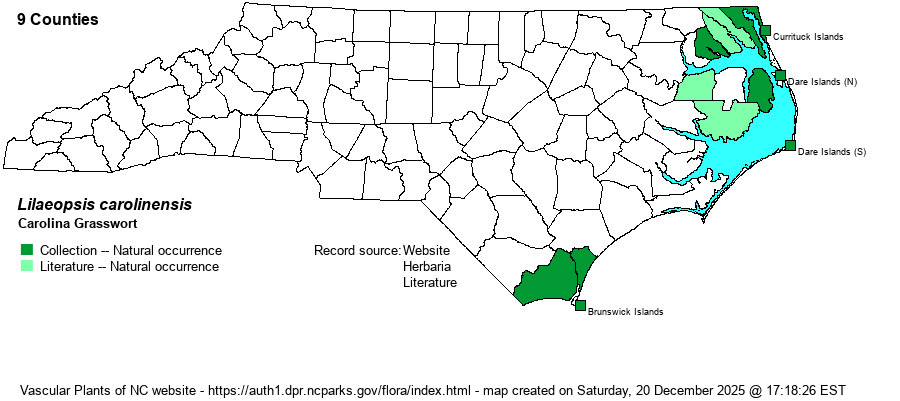| Author | Coulter & Rose | |
| Distribution | Present along most of the tidal shores in the northern half of the coast, to Cape Hatteras; however, seemingly absent southward except in the Cape Fear area of New Hanover and Brunswick counties.
This is a rather scarce coastal species of the South, ranging from southeastern VA to eastern TX, but found mostly along the coasts of NC and SC, and from western FL to eastern TX. It also occurs in South America. | |
| Abundance | Rare to locally fairly common in parts of the northern coastal region; very rare southward, only known from the southeastern corner. This is a Significantly Rare species. Based on the NCNHP database, there are around 25 records, with about 18 still extant. | |
| Habitat | This species is a wetland one of brackish to nearly fresh waters. It grows in freshwater marshes, shores of coastal ponds, margins of bays and sounds, interdune ponds, and even in ditches, where weedy. | |
| Phenology | Blooms in May and June, and fruits shortly after flowering. | |
| Identification | This is a truly odd-looking plant, somewhat reminiscent of a green-colored glasswort (Salicornia spp.). It has a prostrate stem, creeping along the ground. At each of the many nodes, the plant roots, and it also has a pair of fleshy, hollow, rounded or tubular "leaves", yellow-green, erect and to about 8-9 inches tall, with a spatulate tip (flattened and spoon-like); there are 7-15 transverse septa on each leaf. At the nodes also is a single umbel, on a vertical stalk only about 1.5-2 inches tall, much shorter than the leaves. Only 5-15 tiny white flowers are in each umbel. The other member of the genus, the native L. chinensis (despite the name), has the leaves only about 2 inches tall, dark green and evergreen-looking, somewhat flat in cross-section and with a rounded tip. Its flower cluster is on a stalk taller than the height of the leaves. More than likely, you won't see the flower clusters, and they might not even be there. | |
| Taxonomic Comments | None
| |
| Other Common Name(s) | Carolina Lilaeopsis | |
| State Rank | S2 | |
| Global Rank | G3G5 | |
| State Status | SR-O | |
| US Status | | |
| USACE-agcp | OBL link |
| USACE-emp | OBL link |

